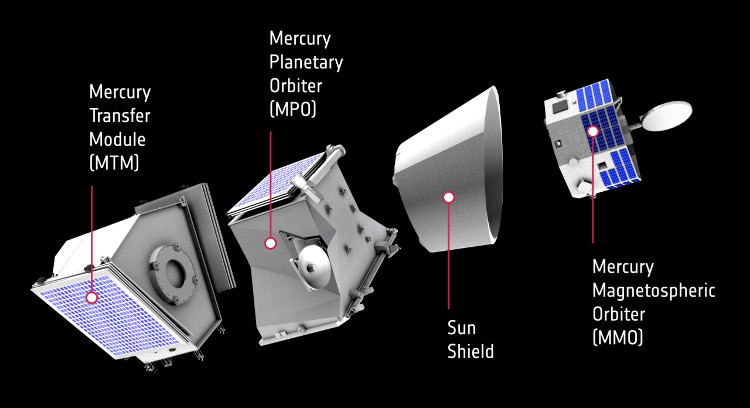The BepiColombo ship and journey to the most mysterious planet of the solar system
On July 6, European and Japanese scientists launched the BepiColombo spaceship before it began its seven-year journey to Mercury to explore one of the most mysterious solar systems. .
This joint project between ESA and the Japanese Space Agency (JAXA) has a total cost of 1.3 billion euros, involving 33 companies from 12 European Union countries (EU), as well as public companies. company from USA and Japan.
The plan to launch BepiColombo has been delayed many times, but now the launch of this spacecraft is almost certainly conducted in October 2018, and BepiColombo will be the first mission of the European Space Agency. (ESA) to this planet closest to the Sun.
The vessel has an unusual design, consisting of a bulge containing two small vessels - one from Europe and one from Japan. These two ships will separate from the mother ship when they arrive at Mercury and fly in two different orbit but complement each other around Mercury.
ESA said BepiColombo will follow the very strange results that the Messenger of the US Aeronautics and Space Agency (NASA) has discovered, from there exploring further the mysteries on Mercury.

The vessel has an unusual design, consisting of a bulge containing two small vessels - one from Europe and one from Japan.
According to ESA scientific director Alvaro Gimenez, Mercury is the most unusual of the rocky planets. Its surface was ruined because of the temperature change to the extreme, from -180 degrees Celsius to 450 degrees Celsius.
It also has a magnetic field and is the only rocky planet outside the Earth to have magnetic fields.
But Mercury is so weak that its surface is not a "shield" that protects you from solar radiation.
Its orbit is 58 million kilometers from the Sun and its surface is destroyed by radiation rays that can destroy all forms of living things that exist on Earth.
The very position close to the Sun makes it difficult to study Mercury from the Earth, because the intensity of the light is too high to interfere with observation.
The strong attraction of the Sun also makes it difficult for a spacecraft to fly in a solid orbit around the planet.
High temperatures also pose major challenges for both Airbus engineers and engineers, and cause the project to be postponed many times.
Airbus said it wrapped the BepiColombo vessel with a specially designed 50-layer insulation material to provide high temperature resistance, while the ship's antenna is made of heat-resistant titanium, coated with a new layer of material. make.
Director of ESA's BepiColombo project, Ulrich Reininghaus for this expedition is like " flying into a giant oven" that can suffer unwanted consequences.
So far, NASA has made two missions to Mercury, made by the Mariner 10 in the 1970s, and the Messenger has been in orbit Mercury since 2011 until the fuel runs out in April 2015.
- Spacecraft begins 7 years journey Mercury
- Solar ships cruise around the world
- NASA first admitted to having a strange planet hidden in the Solar System
- The 9th planet of the solar system is ... stolen goods?
- 99.99% has the 9th planet in the solar system
- Found a way to spot the 9th planet in the Solar System?
- 9th planet: 1 year long with 20,000 years Earth?
- People are about to leave the Solar System
- Shocking theory: The mysterious 9th planet in the Solar System could be a black hole
- The mysterious X planet is devastating the solar system
- The 9th planet can be found in 16 months
- Evidence of the 9th planet of the Solar System
 Van Allen's belt and evidence that the Apollo 11 mission to the Moon was myth
Van Allen's belt and evidence that the Apollo 11 mission to the Moon was myth The levels of civilization in the universe (Kardashev scale)
The levels of civilization in the universe (Kardashev scale) Today Mars, the sun and the Earth are aligned
Today Mars, the sun and the Earth are aligned The Amazon owner announced a secret plan to build a space base for thousands of people
The Amazon owner announced a secret plan to build a space base for thousands of people